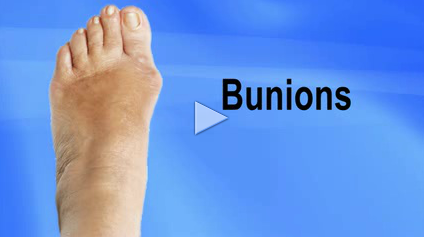All You Need To Know On The Subject Of Bunions
Overview
 Bunions are one of the more serious conditions that can affect foot health. A bunion is actually a bone deformity of the big toe, where the joint at the base and side of the toe is enlarged, forcing the toe out of place. Left untreated, bunions worsen over time. The big toe angles in toward the rest of the toe, and can overlap the third toe (a condition known as Hallux Valgus). Or, it may move toward the second toe and twist or rotate (Hallus Abducto Valgus). Bunions can also lead to deformities like hammertoes. Bunions cause discomfort and pain, because the enlargement constantly rubs against footwear. The skin of the toe becomes red and tender. The larger a bunion grows, the more painful it is to walk. People with bunions can develop thickening skin on the bottom of the foot, bursitis or arthritis, and chronic pain.
Bunions are one of the more serious conditions that can affect foot health. A bunion is actually a bone deformity of the big toe, where the joint at the base and side of the toe is enlarged, forcing the toe out of place. Left untreated, bunions worsen over time. The big toe angles in toward the rest of the toe, and can overlap the third toe (a condition known as Hallux Valgus). Or, it may move toward the second toe and twist or rotate (Hallus Abducto Valgus). Bunions can also lead to deformities like hammertoes. Bunions cause discomfort and pain, because the enlargement constantly rubs against footwear. The skin of the toe becomes red and tender. The larger a bunion grows, the more painful it is to walk. People with bunions can develop thickening skin on the bottom of the foot, bursitis or arthritis, and chronic pain.
Causes
A bunion is more common in women than men due to women wearing tighter fitting shoes. This condition can cause a variety of different soft tissue and bony complaints which may result in severe pain.
Symptoms
No matter what stage your bunion is in, you can be in pain. Though bunions take years to develop, you can experience pain at any stage. Some people don?t have bunion pain at all. Pain from a bunion can be severe enough to keep you from walking comfortably in normal shoes. The skin and deeper tissue around the bunion also may become swollen or inflamed.
Diagnosis
The doctor considers a bunion as a possible diagnosis when noting the symptoms described above. The anatomy of the foot, including joint and foot function, is assessed during the examination. Radiographs (X-ray films) of the foot can be helpful to determine the integrity of the joints of the foot and to screen for underlying conditions, such as arthritis or gout. X-ray films are an excellent method of calculating the alignment of the toes when taken in a standing position.
Non Surgical Treatment
Wide shoes with plenty of space for the toes are the first place to start. Along these lines, a shoe can be focally stretched directly over the painful bunion using a device known as a ?ball and ring? shoe stretcher. Additionally, numerous commercial bunion braces and splints are available to help keep the big toe in better alignment. 
Surgical Treatment
There are many different procedures that have been described to correct bunions. The type of operation your foot surgeon recommends to correct your bunion should be dictated by the severity of your bunion deformity and the surgeon?s preference. There are well over 100 different bunion correction procedures described in the orthopaedic literature. However, the broad categories of bunion correction procedures are listed below. Removal of the medial eminence. Distal metatarsal osteotomy (chevron) with great toe soft-tissue tightening (medial capsular tightening and distal soft-tissue repair). Proximal metatarsal osteotomy Ludloff, Cresentic, SCARF, medial opening wedge) with with great toe soft-tissue tightening (medial capsular tightening and distal soft-tissue repair). Lapidus hallux valgus correction (first tarsometatarsal joint fusion) with distal soft tissue procedure. Great Toe Fusion (1st MTP joint arthrodesis). Akin osteotomy (Realignment bone cut at the base of the big toe). Removal of the medial eminence with suture stabilization of the first and second metatarsals. Keller joint arthroplasty (removal of the proximal aspect of the proximal phalanx).
Prevention
To minimize the chance of developing bunions, never force your feet into shoes that don?t fit. Choose a shoe that conforms to the shape of your foot. Opt for shoes with wider insteps, broad toes, and soft soles. Shoes that are short, tight, or sharply pointed should be avoided.